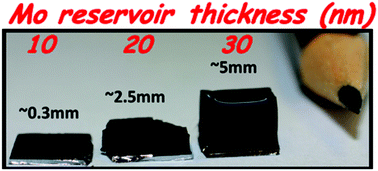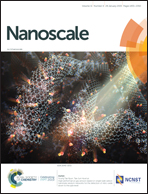Modulating the height of carbon nanotube forests by controlling the molybdenum thin film reservoir thickness†
Abstract
Many catalyst materials have been tried to synthesize ultra-long carbon nanotubes (CNTs) by extending catalyst lifetime and delaying growth termination. We propose a time-controlled, variable composition iron–molybdenum catalyst system, where the diffusion of molybdenum (as a thin layer reservoir) is mediated by the alumina underlayer, to reach and to slowly alloy with the Fe catalyst on the surface during the thermal process. This technique enhanced both the catalytic activity and the catalytic lifetime to grow CNT carpets with heights up 5 mm, compared to a maximum of approximately 1.5 mm for a regular sample (without Mo reservoir). Moreover, the CNT height increased with the thickness of the Mo thin layer reservoir for thicknesses from 10 nm to 30 nm. We discuss this new growth mechanism using high resolution transmission microscopy (HRTEM) images of cross-section lamellas and Rutherford Back Scattering (RBS) analysis to show the increasing alloying of Mo with Fe. Overall, the proposed technique of mediated diffusion of Mo to the surface with subsequent progressive alloying with the Fe catalyst, besides enhancing CNT height, could allow the one-step synthesis of CNT carpets with regions of different heights based on patterning these regions with different thicknesses of the Mo reservoir during sample preparation.



 Please wait while we load your content...
Please wait while we load your content...